
DEOS will provide will provide common enterprise applications in disconnected environments.
The COVID-19 pandemic has pushed the Pentagon to move from aging software to Microsoft Office 365 much faster than planned. That means, for example, that users will have the ability to dial into Teams meetings from their home phones, laptops, and other devices as early as January 2021.
The capability, known as DoD365, is an offshoot of the $4.4 billion 10-year Defense Enterprise Office Solutions (DEOS) cloud contract awarded to General Dynamics Information Technology. DEOS will provide common enterprise applications at local base, post, camp, and station levels—including deployed units and ships afloat. Under DEOS, the Pentagon will transition to cloud-based Microsoft productivity software such as Office 365 that provides word processing, spreadsheets, email, collaboration, file sharing, audio/video, and storage in a single package — moving away from the separate, single-purpose applications that presently reside mostly on legacy desktop computers.
The Defense Department emphasizes that DoD365 does not replace DEOS or mean DEOS is being cancelled. To the contrary, officials say, DoD365 is an acceleration of DEOS. The DEOS program will continue to pursue larger enterprise goals of interoperability, security, Secret Internet Protocol Router Network (SIPRNet) services, records management, and an outside-the-continental-U.S. (OCONUS) presence for O365.
“The department was already moving fast into Office 365,” said Caroline Bean, program director of the Defense Enterprise Office Solution (DEOS) at the Defense Information Systems Agency, speaking yesterday at the virtual AFCEA TechNet conference. “However, the current pandemic that swept across our nation has accelerated the need for these services due to agencies having to swing into maximum telework through the pandemic.”
The initial DEOS phase will focus on providing a Non-Classified Internet Protocol Router Network (NIPRNet)-based solution located in the continental U.S. (CONUS). Follow-on efforts will include a classified SIPRNet-based solution worldwide, as well as instances designed to address tactical-edge environments.
Regarding the expansion of DEOS to SIPRNet, Bean emphasized that “the goal for the SIPRNet environment is to be a single (environment), not a federated environment that we are operating today on the NIPRNet.”
While DEOS may look like just another piece of back-office IT, officials argue it can also be considered a weapon system. Why? Because it will provide common enterprise applications to units at home and deployed, including ships at sea, over NIPRNet and SIPRNet — even in conflict zones where adversaries are attacking U.S. communications networks, what’s known as Denied, Disconnected, Intermittent, and Limited bandwidth (DDIL) environments.
During a vibrant chat session that went on for about 30 minutes after the conclusion of Bean’s presentation, she responded to a variety of questions from conference attendees about DEOS. Choice excerpts follow;
Q: Will O365 [Microsoft Office 365] be a system of record or will military commands need to move data out of O365 for records and Privacy Act purposes?
Bean: We will have a System of Records Notices (SORN) for the data that will be stored in O365. But it is also the responsibility of the data owner to follow SORN policies for their agency or organization.
Q: Please explain the difference between the federated environment that we have on NIPRNet and the single environment for SIPR?
Bean: We have multiple approved tenants currently on NIPRNet. DoD365 is the approved tenant for the 4th Estate Agencies and select CCMDs (Combatant Commands) that decide to join our tenant. All the MILDEPs (Military Departments) have been approved to have their own tenant, as well. That’s the federated model we are under now on NIPRNet. For SIPRNet, we plan on only having one tenant architecture approved for all MILDEPs, CCMDs and agencies to use.
Q: Explain the difference between the DEOS Program and the DEOS Contract?
Bean: The DEOS contract is specific to the BPA that has been awarded to GDIT. The DEOS program encompasses more than just the contract. It also runs the DoD365 effort that is now under the DEOS umbrella. DoD365 is only limited to NIPRNet CONUS, whereas the DEOS contract has been put in place to respond to OCONUS, DDIL and SIPRNet requirements.
Q: Will the DEOS PMO use the DEOS contract to issue task orders to cover the federation of Army, Navy, USAF, and DoD365 tenants? Or will each tenant have to issue their own federation task order?
Bean: DISA will be executing a task order to have GDIT take over the management of our DoD365 tenant. USAF, USN, etc., will need to execute their own task orders against the DEOS BPA if they would like GDIT to manage their tenants for them.
Q: Will your command-level governance/exceptions to the central rules happen with delegated command administration or through a centralized management structure like an all-tenant governance committee?
Bean: Due to the aggressive timelines that we are under to migrate all DAFAs (Defense Agencies and DoD Field Activities) and CCMDs, we will place some, but not much, constraints in the beginning at the tenant level. The idea will be to stand up a board that would approve tenant-level changes where each CCMD and DAFA would have a seat at the table.






















